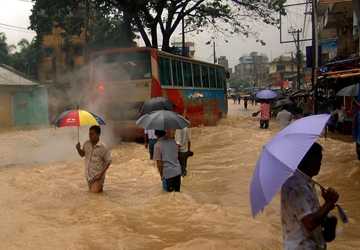
Investors who fixate on the bleak economic picture may be missing a significant risk that originates from the environment, which is the effect of climate change. Storm clouds in the current economic environment pose several risks to asset markets. There is a growing risk that severe weather disasters, such as hurricanes, storms, and floods, may physically interrupt business operations and supply worldwide. These types of occurrences are also becoming more often. We are inching our way closer to a new normal in which catastrophes costing a billion dollars or more occur more frequently.
We have accumulated data on climate and business facilities to construct a score to assess corporations according to their sensitivity to extreme climate and weather. The overall risk an organization faces is broken down into three distinct components by the scoring system. These are the chain risk, market risk, and operations risk.
These 10 Stocks Are the Most Vulnerable to the Effects of Climate Change
(Total Score Determined by Risks in the Market, Supply Chain, and Operations)
- NCLH, often known as Norwegian Cruise Line Holdings; Total Score = 100

- Western Digital Corporation (WDC); Overall Rating: 89.2
- NextEra Energy (NEE) has an overall score of 86.5
- Micron Technology (MU), with a total score of 80.2
- Eastman Chemical (EMN), with a total score of 80.
- Consolidated Edison (ED) has a total score of 79.6
- Seagate Technology (STX), with a total score of 77.7
- Merck (MRK); Overall Score = 76.9 Points
- Applied Materials (AMAT); Overall Score Is 76.3
- Enterprise Public Sector (PEG); Overall Score = 74.6
Exactly What This Implies for Investors
Consolidated Edison, which came in sixth overall and scored 79.6 out of 100, occupied the sixth slot. Operational risk, which accounts for almost 70% of each business's overall score, aims to quantify the dangers presented by climate change and extreme weather events, including heat waves, sea level rise, and storms; the utility company received a score of 49.7 on this metric. ConEd is particularly susceptible to the effects of rising sea levels due to the location of its infrastructure in New York City. The company's plants in southern Texas and California are also subject to additional water- and heat-related challenges.
Chain risk and market risk account for 30% of the total score. Con Ed got 70.1 and 38.4, respectively, for these two risk categories. The first method evaluates the susceptibility of a firm's end market to climate risk. In contrast, the second method considers the climate-associated risks with nations that are likely to be a part of a business's supply chain.
Looking Ahead
Investors must pay special attention to how climate change risk assessment methodologies are employed and whether or not they effectively reflect a company's susceptibility because climate change risk assessment methods are still in their developmental stages. Both picking stocks and making accurate weather forecasts have always required some guesswork, but in today's world, the two are more intertwined than ever.


